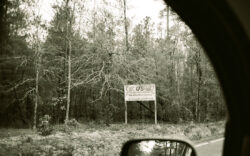There are some weeks when a pundit recoils from the dismal complexities of the unrelenting news cycle and seeks solace in memories of times that look simpler in retrospect.
Regular readers of this column will recall that at one time, nearby Greene County had in residence, all at the same time, in Greensboro: Dr. Raper, Dr. Killam and Dr. Slaughter.
Dr. Raper was the eminent University of North Carolina sociologist, who lived there several years while researching two books about the county during the Depression: Preface to Peasantry and Tenants of the Almighty.
Dr. Killam was a physician, originally from Boston—a dapper man with a grey mustache, usually wearing a three-piece suit. (He sewed up Sonny Thurmond’s head the day he fell on our front porch, made dizzy by my efforts to help him get into shape for football with exercises from the Royal Canadian Air Force. But that’s another story).
Mrs. Killam was from Honduras, and they were our neighbors. Dr. Killam’s office was in their home, and their children—Horace, Christine and Peter—were in school with us. We played football with Peter. Mrs. Killam doubled as her husband’s nurse.
Dr. Slaughter was our dentist, and Mrs. Slaughter was his assistant. Dr. Slaughter’s office was above our family store, where, down the hall, my Uncle Bill, the funeral director, had stored the body of “Oscar,” a man who died while passing through Greensboro in 1938, with no known family or other contacts. Some of the country people would not go upstairs, for fear either of Oscar, or of Dr. Slaughter, or both.
After Dr. Slaughter’s demise, the grim doctoral roster was relieved by the advent of our new dentist, Dr. Easley, though Mrs. Killam did become his assistant.
Does this litany suggest that Greensboro incubated eccentricity? Would that surmise be enhanced by the information that Moore’s Pharmacy boasted Nancy, the dapper little man with the leather bowtie, who delivered fountain Cokes downtown on a tray carried by his upraised fingertips?
Or what about Chief Hunter, our lone policeman, remembered for the high-pitched snarl in which he expressed the certainty that he always knew when somebody might be trying to put something over on him, like the traveling salesman who made a U-turn in the middle of Main Street one day and was accosted by Chief Hunter.
“Hey, don’t you know you can’t do that?” Chief Hunter announced to the startled salesman.
“I’m sorry, officer,” he responded. “I’m from Cincinnati.”
“Don’t hand me that crap,” the chief shot back. “I see that Ohio tag on your car.”
Ta dum.
For the sake of Milton Leathers, who has always been intrigued by it, I will close this recitation by repeating the story told me by my Uncle Lawton. Perhaps Unc’s experience provides a moral that shows how hometown lore prepares us for the world we will live in—especially this world now and the values that trickle down to us from the very top.
Uncle Lawton bought a new set of tires for his car, or swapped a shotgun for them or something, and he stored them under his house until he could afford to have them mounted on his car. Milton has never understood why anybody would store tires under a house, but Unc lived out on the Siloam Road in a converted one-room store building, and he didn’t have a garage.
Anyway, Uncle Lawton returned home one day to to find his best friend, who must remain nameless here because of family connections, in the act of loading Unc’s new tires into the trunk of his own car. Upon being caught and confronted, the friend drew himself up to his full five-and-a-half feet and declared, “Lawton, this may look bad to you, but you have to understand that what used to be considered crooked, is now considered good bidness.”
Selah.
Like what you just read? Support Flagpole by making a donation today. Every dollar you give helps fund our ongoing mission to provide Athens with quality, independent journalism.









